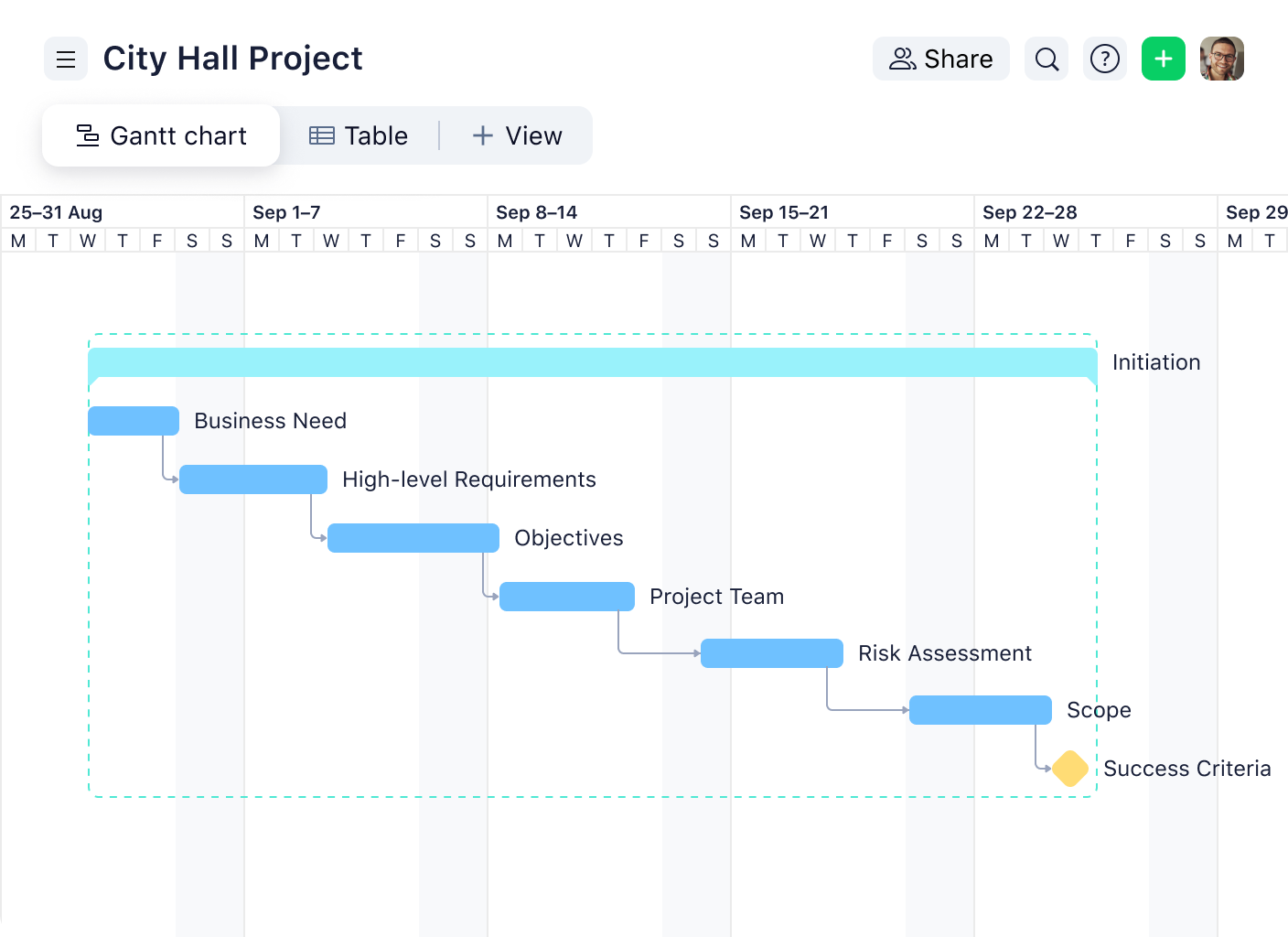- 1. What Is the Agile Manifesto?
- 2. The Benefits and Advantages of Agile
- 3. What Is Agile Operations?
- 4. The Agile Software Development Life Cycle
- 5. Building an Agile Team Structure
- 6. A Guide to the Scaled Agile Framework (SAFe)
- 7. Agile and Lean Portfolio Management
- 8. Understanding Squads, Tribes, and Guilds
- 9. What Is Agile Transformation?
- 10. Themes, Epics, Stories, and Tasks in Agile
- 11. A Complete Guide to Agile Epics
- 12. How to Create User Stories
- 13. Agile Estimation: Understanding Story Points
- 14. Using Gantt Charts in Agile
- 15. Glossary
- 16. FAQs
- 1. What Is the Agile Manifesto?
- 2. The Benefits and Advantages of Agile
- 3. What Is Agile Operations?
- 4. The Agile Software Development Life Cycle
- 5. Building an Agile Team Structure
- 6. A Guide to the Scaled Agile Framework (SAFe)
- 7. Agile and Lean Portfolio Management
- 8. Understanding Squads, Tribes, and Guilds
- 9. What Is Agile Transformation?
- 10. Themes, Epics, Stories, and Tasks in Agile
- 11. A Complete Guide to Agile Epics
- 12. How to Create User Stories
- 13. Agile Estimation: Understanding Story Points
- 14. Using Gantt Charts in Agile
- 15. Glossary
- 16. FAQs
Gantt charts date back to the mid-1890s, with the widely used version developed by American engineer Henry Gantt. They are often associated with the Waterfall model, a traditional project management methodology, where you must complete one task before moving on to the next one. This corresponds with Gantt chart tasks, which we’ll discuss in more detail later.
However, Gantt charts can also be a highly useful tool in Agile project management, offering an iterative approach to the software development process. Industrial engineer H. K. Hathaway said: “For continuous flow production such as this, I know of nothing better for recording output and comparing performance with capacity or what ought to be produced, than the straight line charts developed by Mr. H. L. Gantt, which show required and actual production in terms of both quantity and time. Their use, however, is not limited to the class of work just described.”
This quote is interesting because it highlights the versatility of the Gantt chart. Though it was developed more than a century ago in a traditional work environment, it can be adapted to suit the Agile methodology, a more modern approach that has grown in popularity since the birth of the Agile Manifesto in 2001.
So, how exactly do Gantt charts fit into Agile methodology? Let’s take a closer look.
What is an Agile Gantt chart?
An Agile Gantt chart is a project management tool in the form of a bar chart. It offers a timeline view of an Agile project, via a vertical list of tasks on the left-hand side with corresponding start and end dates. These tasks are also visually represented on the right-hand side with horizontal bars. The length of the bars corresponds to the amount of time your task will take.
If your Agile teams are new to Gantt charts, it’s worth clarifying the following terms:
- Bars: Agile project tasks are represented by rectangular bars. These bars are often color coded to differentiate clearly between tasks.
- Dependencies: A dependency is a link between two tasks, where one is dependent on the other. Lines or arrows will connect tasks on a Gantt chart, showing which ones need to happen in a certain order.
- Dateline: This is a line on top of the horizontal axis that shows calendar dates.
- Milestones: A milestone is a specific point in an Agile project’s lifecycle that is used to measure progress. It is represented by a diamond-shaped icon.


Now that you can recognize these handy tools, let’s discuss why you should use a Gantt chart for your Agile project.
Why do Agile teams use Gantt charts?
A Gantt chart can help single or multiple teams break large Agile epics down into smaller user stories and tasks to effectively visualize and manage their Agile workflow. They can plan their project schedule, spot potential bottlenecks, and produce deliverables on time. Because Agile projects are not typically static due to changing requirements, it’s important to have adaptable Gantt chart software so you can adjust deadlines and reassign team members if necessary.
For Scrum teams, in particular, a Scrum Gantt chart can help with the sprint planning process. A Scrum master can use this flexible software to organize sprint tasks and get a clear view of their project progress.
A Gantt chart is similar to an Agile dependency diagram but provides more information and places a larger focus on the time taken to complete an Agile project. It also offers more functionality than a traditional project calendar, with the extra addition of task dependencies.
How to use an Agile Gantt chart
Now you know the importance of a Gantt chart for Agile methodology, let’s look at how to build one for your project.
Step 1: Create tasks
Add a new task for every user story in your project iteration or sprint. Add subtasks for larger stories. Include detailed descriptions and attachments, so your team members have all the information they need.
Step 2: Add dependencies and milestones
Create a start-to-finish dependency for each task in your iteration. In this model, Task B cannot start until Task A is finished. You can also link milestones to your dependencies to ensure your project stays on schedule.
Step 3: Assign roles
Outline the project roles and responsibilities. Check that you have sufficient resources and that your team members are available to take on new tasks. Then, you can assign people to each task.
Step 4: Track progress
Agile teams have daily standup meetings where they collaborate and discuss an iteration’s progress. Use these meetings to review your Gantt chart progress bars and make adjustments where necessary.
Once your Gantt chart is up and running, set aside some time to check in with your team. Ensure they are comfortable using the Gantt chart software and prepare additional training sessions if needed.
Benefits of Agile Gantt charts
Why should your team consider using Agile Gantt charts? Here are some of the potential benefits:
Visibility
Gantt charts offer a bird’s-eye view of an Agile project, making it easy for a project manager or product owner to track work and view progress at a glance. They create a clear roadmap that you can share with clients and other stakeholders.
Simplicity
As mentioned, Gantt charts help teams to break complex Agile projects (epics) down into smaller, bite-size pieces (user stories). You can store all your data in tasks and subtasks, but the Gantt chart view allows you to manage and process it more easily.
Flexibility
Gantt charts are compatible with the Agile mindset because they can be adapted without disruption. Updating Gantt charts can easily be accomplished by swiftly moving due dates and milestones, so that project timelines can reflect changing client priorities.
If you want to explore the multiple benefits of using a Gantt chart in Agile, why not try flexible work management software such as Wrike?
Agile Gantt charts in Wrike
With Wrike, you’ll get access to an Agile project management platform with intuitive Gantt chart software that can be tailored to suit your Agile projects. Take a look at some of our best practices:
- Use the drag-and-drop builder to adjust deadlines and milestone dates in seconds. The dynamic timeline will automatically update all task dependencies.
- Keep your colleagues in the loop with real-time updates and automatic notifications when you make a change.
- Say goodbye to spreadsheets — import your Agile project files and integrate with 400+ apps to keep all your data in one place.
Get 360° visibility on your projects with Agile Gantt charts in Wrike — take a tour today to find out how your organization can stay on top of project planning in a pure Agile environment.

Alex Zhezherau
Alex is Wrike’s Product Director, with over 10 years of expertise in product management and business development. Known for his hands-on approach and strategic vision, he is well versed in various project management methodologies — including Agile, Scrum, and Kanban — and how Wrike’s features complement them. Alex is passionate about entrepreneurship and turning complex challenges into opportunities.

